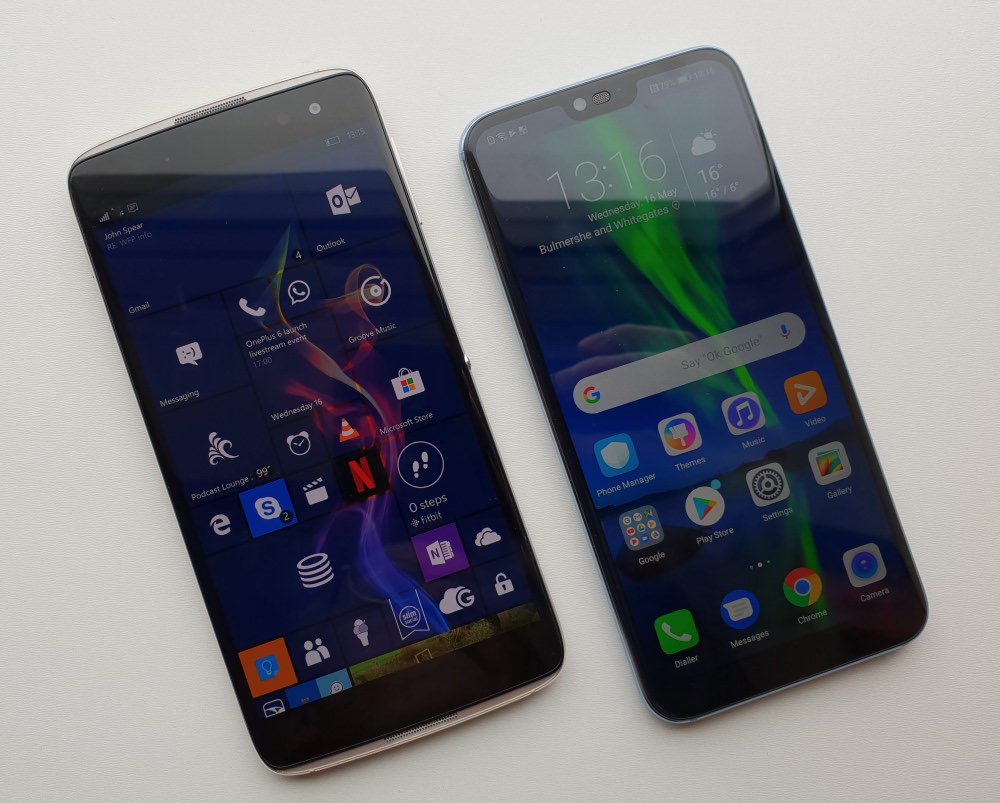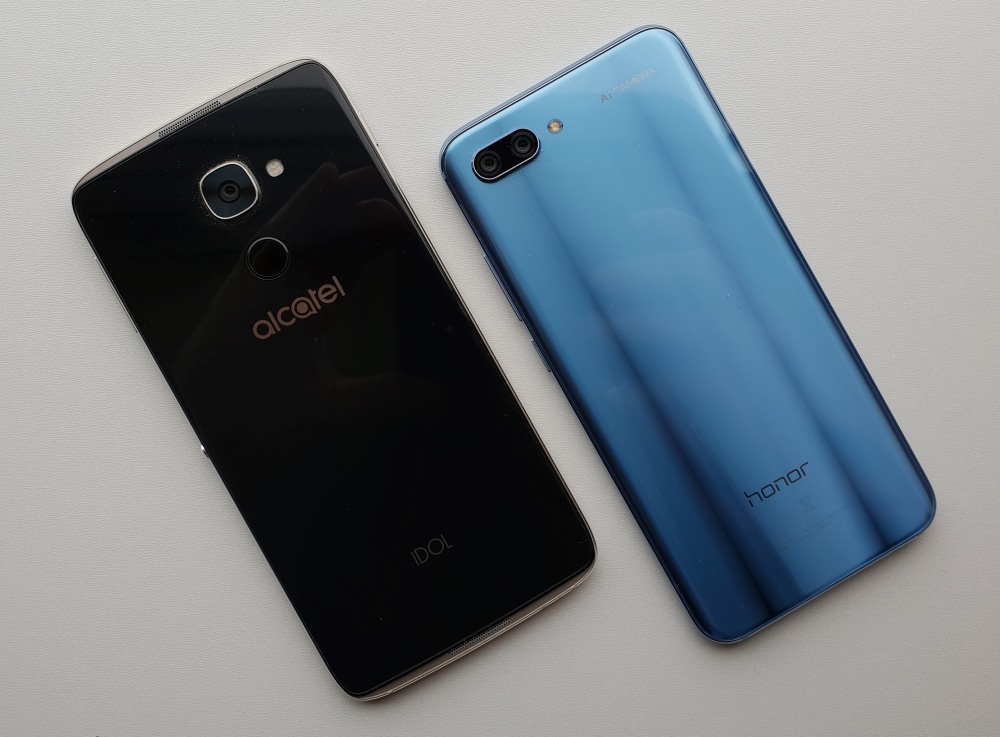
As usual, I've shaded in green an obvious 'win' for either device, I honestly have no idea which way this one's going to go (as I start to compile the feature)... Any row where a winner would be totally subjective is left uncoloured. Or, where both devices are utterly excellent but in different ways, I've given both a 'green'(!)
| Alcatel IDOL 4 Pro | Honor 10 | |
| Date first available | August 2017 | May 2018 |
| Current price, availability | Currently sold out from the Microsoft online Store in the UK. See your local version for pricing and - maybe - clearance deals. Or get it from Microsoft France or Microsoft Germany and live with the mains adapter? Guide price £250. | £399, SIM-free, inc VAT |
| Dimensions, form factor, weight, design |
154 x 75 x 7mm, aluminium frame with toughened glass front and back, 152g |
150 x 71 x 8mm, aluminium with 2.5D toughened glass front and back, 153g, slightly shorter, narrower and thicker, but very similar form factors overall. |
| Durability | No specific durability metrics, plus the dual sided glass design means a case is a must. If water gets in then you're pretty much out of luck. Sadly. |
Again, no specific durability metrics, plus the dual sided glass design means a case is a must. (You do get a clear TPU case in the box.) |
| Operating system, interface | Windows 10 Mobile (now running Fall Creators Update), (dismissable) virtual controls, for maximum screen real estate. |
Android 8.1, with Emotion UI 8.1 on top, virtual controls can be replaced by fingerprint sensor gestures, for maximum screen real estate. |
| Display | Samsung-made 5.5" AMOLED 16:9 1080p panel, Dragontrail Glass, excellent colour balance, contrast and viewing angles. Screen area is approximately 84 cm2 |
5.84" IPS LCD '2 by 1' 1080p screen, Gorilla Glass, decent screen but it can't match the IDOL 4 Pro's contrast and colours overall. Screen area is fractionally larger, at approximately 85cm2 |
| Connectivity | LTE up to 300Mbps (all bands), Wi-Fi b/g/n/ac, integral wifi tethering, Bluetooth 4.1, Continuum connectivity to use external displays as secondary screen, independent of the phone display. Note that there's no NFC, though there's also no Microsoft contactless payment tech in the platform worldwide yet either, so the omission is moot! | LTE, NFC (all uses, including Android Pay), Wi-Fi b/g/n/ac, integral wifi tethering, Bluetooth 4.2 (all uses). NFC should win the day here, but the IDOL 4 Pro's wired and wireless Continuum compatibility does add a certain levelling factor. |
| Processor, performance | Snapdragon 820 chipset, 4GB RAM (of which only 3.5GB can be used directly), the fastest Windows phone I've tested so far, despite the lack of TLC from Microsoft or Alcatel in terms of tuning. | Kirin 970 chipset with 4GB RAM. Very fast at everything. |
| Capacity | 64GB internal storage, expandable via microSD. | 128GB internal storage, no expansion |
| Imaging (stills) |
21MP f/2.2 1/2.4" BSI sensor, dual LED flash, HDR shots, PDAF, very decent shots in most light conditions, but capture is relatively slow and it all falls down in really low light, as you'd expect (with no OIS). See my review part 2. 8MP front camera |
16MP f/1.8, plus 24MP monochrome sensor, PDAF, LED flash. Camera tests still ongoing, but the more modern sensors and some clever AI enhancement ensures better photos. A comparison with Lumia 950 photos is coming soon, that should be a much closer match. 24MP front camera, f/2.0 |
| Imaging (video) | 4K, optionally digitally stabilised, with 'Best photo' 8MP grabbing built-in, plus high amplitude stereo audio recording (though left and right channels are randomly(?) switched in current firmware). See my review part 3. | Up to 4K video capture, digitally stabilised, high quality stereo audio. |
| Music and Multimedia (speakers) |
Terrific front-facing 3.6W stereo speakers, arguably the best in the current smartphone world - in any ecosystem - if you discount Dolby Atmos and other EQ enhancers. | Fairly quiet mono speaker on the bottom edge. |
| Music (headphones) | 3.5mm headphone jack, excellent DAC for audio output. Plus A2DP over Bluetooth. | 3.5mm headphone jack, average DAC built-in. Plus A2DP and AptX HD over Bluetooth |
| Navigation | Windows 10 Maps is comprehensive, has a degree of live traffic awareness (see the latest workaround), Includes full offline maps with automatic updates (though we haven't had one for a while, summer 2018 is the next scheduled!) |
Google Maps is now the gold standard in phone navigation, tied in with many other Google services and offering true real time navigation around traffic issues. Some degree of offline capability, thanks to user-selectable cached areas. |
| Cortana/Voice | Cortana is now mature and well integrated, and with a surprising degree of 'assistance'. | Google Assistant is baked in, and arguably the pick of the current voice aids. But do any of us use them much on our phones? |
| Battery, life | Sealed 3000mAh battery, plus USB Type C fast charging (up to 2A) and compatibility with Qualcomm's Quickcharge 3.0. | Sealed 3400 mAh battery. Charging is Huawei's proprietary 'SuperCharge' via the USB Type C port. It's unclear what current this draws from more generic chargers, am guessing 2A. |
| Cloud aids | Windows Photos syncs across all signed-in devices, subject to your OneDrive tariff, should you have thousands of images in the system. Plus Windows 10 backs all your media, application data and settings to a separate backup folder system, tariff-free on OneDrive. | Google Photos, once installed, does a great job of organising photos and syncing them across all signed-in phones and tablets. You do lose some quality unless you pay, but this is comparable to the Microsoft tariffs for OneDrive, etc. |
| Biometrics | The fingerprint sensor is slower than most in the industry, and it's not clear why! Plus the 'Hello' animation takes a second. On the positive side, it's a lot faster than PIN entry or iris recognition. On the (other) negative side, there's no Microsoft Wallet/Pay (even if there was NFC, which there isn't!) So that side of things is a no go. | The fingerprint sensor on the front works OK once you get the hang of its location (it's under the front glass) and quirks - you have to press down fairly firmly, to present an accurate fingerprint to the ultrasonic detection system. And the drivers for it are currently buggy, though no doubt they'll get fixed up in time and then this row would be a win for the Honor 10. Nowhere near as fast as capacitive fingerprint sensors, though. Works with Android Pay. |
| Applications and ecosystem | Windows 10 Mobile now has just about every mainstream app covered, aside from Snapchat and Tinder. And anything to do with Google services! Most things can be done via Edge, though 'not quite' as slickly as with dedicated applications. | The might of Google and Android's app ecosystem - everything is available and almost always in first party form. |
| Upgrades and future |
Windows 10 Mobile will be updated through 2018 and the whole of 2019, of course, as part of the global Windows 10 ecosystem and the regular patching and fixing process for the 'Fall Creators Update' branch. Production devices can expect updates every month. Would love to give the IDOL 4 Pro the win here on this technicality, but suspect I'd get shouted at! |
Honor has a slightly patchy record for OS and security updates, but I get the feeling things are improving now. Still, I doubt it'll get the mandatory longevity of the Windows 10 phone here. Just saying... |

Verdict
Adding up the green 'wins' gives a 4-4 score draw with the new Honor flagship, which will be a 4-5 loss when Honor sorts out its fingerprint sensor code in a firmware update. Most functions considered were actually pretty even though - these two phones aren't that far apart overall. Which is a compliment to the Windows 10 device, considering that it's basically a 2016 design and spec at heart.
As with previous comparisons though, there's massive competition in the Android world for this new Honor phone, whereas the Alcatel IDOL 4 Pro is more or less the only game in town for someone happy with Windows 10 Mobile and wanting new hardware.
Of the IDOL 4 Pro's 'wins' above, the most significant is that for multimedia, with the genuinely incredible speakers, high quality DAC, and fabulous display, all giving the phone something of a class-leading USP. The IDOL 4 Pro's not a perfect handset, of course - not even close, but it's not bad and I for one am glad that it exists at all. Kind of a 'last hurrah' for Windows 10 Mobile?
PS. Next up from me will be a camera shootout between the Honor 10 and the Lumia 950 - Honor claims all sorts of AI advances in imaging, so we'll have to see how they stack up against the best!
PPS. If you do pick the IDOL 4 Pro up then you'll need a case. See my IDOL 4 Pro case round-up here, recently added to.
